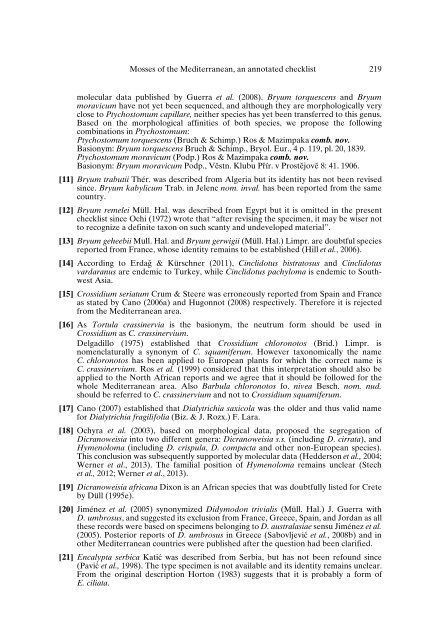Mosses of the Mediterranean, an annotated checklist - Optima-bot.org
Mosses of the Mediterranean, an annotated checklist - Optima-bot.org
Mosses of the Mediterranean, an annotated checklist - Optima-bot.org
You also want an ePaper? Increase the reach of your titles
YUMPU automatically turns print PDFs into web optimized ePapers that Google loves.
<strong>Mosses</strong> <strong>of</strong> <strong>the</strong> <strong>Mediterr<strong>an</strong>e<strong>an</strong></strong>, <strong>an</strong> <strong>an</strong>notated <strong>checklist</strong> 219molecular data published by Guerra et al. (2008). Bryum torquescens <strong>an</strong>d Bryummoravicum have not yet been sequenced, <strong>an</strong>d although <strong>the</strong>y are morphologically veryclose to Ptychostomum capillare, nei<strong>the</strong>r species has yet been tr<strong>an</strong>sferred to this genus.Based on <strong>the</strong> morphological affinities <strong>of</strong> <strong>bot</strong>h species, we propose <strong>the</strong> followingcombinations in Ptychostomum:Ptychostomum torquescens (Bruch & Schimp.) Ros & Mazimpaka comb. nov.Basionym: Bryum torquescens Bruch & Schimp., Bryol. Eur., 4 p. 119, pl. 20, 1839.Ptychostomum moravicum (Podp.) Ros & Mazimpaka comb. nov.Basionym: Bryum moravicum Podp., V≥stn. Klubu P÷ír. v Prost≥jov≥ 8: 41. 1906.[11] Bryum trabutii Thér. was described from Algeria but its identity has not been revisedsince. Bryum kabylicum Trab. in Jelenc nom. inval. has been reported from <strong>the</strong> samecountry.[12] Bryum remelei Müll. Hal. was described from Egypt but it is omitted in <strong>the</strong> present<strong>checklist</strong> since Ochi (1972) wrote that “after revising <strong>the</strong> specimen, it may be wiser notto recognize a definite taxon on such sc<strong>an</strong>ty <strong>an</strong>d undeveloped material”.[13] Bryum geheebii Mull. Hal. <strong>an</strong>d Bryum gerwigii (Müll. Hal.) Limpr. are doubtful speciesreported from Fr<strong>an</strong>ce, whose identity remains to be established (Hill et al., 2006).[14] According to Erda∑ & Kürschner (2011), Cinclidotus bistratosus <strong>an</strong>d Cinclidotusvardar<strong>an</strong>us are endemic to Turkey, while Cinclidotus pachyloma is endemic to SouthwestAsia.[15] Crossidium seriatum Crum & Steere was erroneously reported from Spain <strong>an</strong>d Fr<strong>an</strong>ceas stated by C<strong>an</strong>o (2006a) <strong>an</strong>d Hugonnot (2008) respectively. Therefore it is rejectedfrom <strong>the</strong> <strong>Mediterr<strong>an</strong>e<strong>an</strong></strong> area.[16] As Tortula crassinervia is <strong>the</strong> basionym, <strong>the</strong> neutrum form should be used inCrossidium as C. crassinervium.Delgadillo (1975) established that Crossidium chloronotos (Brid.) Limpr. isnomenclaturally a synonym <strong>of</strong> C. squamiferum. However taxonomically <strong>the</strong> nameC. chloronotos has been applied to Europe<strong>an</strong> pl<strong>an</strong>ts for which <strong>the</strong> correct name isC. crassinervium. Ros et al. (1999) considered that this interpretation should also beapplied to <strong>the</strong> North Afric<strong>an</strong> reports <strong>an</strong>d we agree that it should be followed for <strong>the</strong>whole <strong>Mediterr<strong>an</strong>e<strong>an</strong></strong> area. Also Barbula chloronotos fo. nivea Besch. nom. nud.should be referred to C. crassinervium <strong>an</strong>d not to Crossidium squamiferum.[17] C<strong>an</strong>o (2007) established that Dialytrichia saxicola was <strong>the</strong> older <strong>an</strong>d thus valid namefor Dialytrichia fragilifolia (Biz. & J. Rozx.) F. Lara.[18] Ochyra et al. (2003), based on morphological data, proposed <strong>the</strong> segregation <strong>of</strong>Dicr<strong>an</strong>oweisia into two different genera: Dicr<strong>an</strong>oweisia s.s. (including D. cirrata), <strong>an</strong>dHymenoloma (including D. crispula, D. compacta <strong>an</strong>d o<strong>the</strong>r non-Europe<strong>an</strong> species).This conclusion was subsequently supported by molecular data (Hedderson et al., 2004;Werner et al., 2013). The familial position <strong>of</strong> Hymenoloma remains unclear (Stechet al., 2012; Werner et al., 2013).[19] Dicr<strong>an</strong>oweisia afric<strong>an</strong>a Dixon is <strong>an</strong> Afric<strong>an</strong> species that was doubtfully listed for Creteby Düll (1995e).[20] Jiménez et al. (2005) synonymized Didymodon trivialis (Müll. Hal.) J. Guerra withD. umbrosus, <strong>an</strong>d suggested its exclusion from Fr<strong>an</strong>ce, Greece, Spain, <strong>an</strong>d Jord<strong>an</strong> as all<strong>the</strong>se records were based on specimens belonging to D. australasiae sensu Jiménez et al.(2005). Posterior reports <strong>of</strong> D. umbrosus in Greece (Sabovljevi† et al., 2008b) <strong>an</strong>d ino<strong>the</strong>r <strong>Mediterr<strong>an</strong>e<strong>an</strong></strong> countries were published after <strong>the</strong> question had been clarified.[21] Encalypta serbica Kati† was described from Serbia, but has not been refound since(Pavi† et al., 1998). The type specimen is not available <strong>an</strong>d its identity remains unclear.From <strong>the</strong> original description Horton (1983) suggests that it is probably a form <strong>of</strong>E. ciliata.






